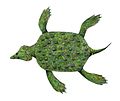London specimens
The holotype is NHMUK R.8431, a partial skull previously referred to Cryptoclidus eurymerus . It was discovered alongside the second specimen by Peter Langham at Endcome Bay, Dorset in 1976 and was named as Kimmerosaurus langhami by Brown (1981b). [2]
NHMUK PV R 10042, a skull and five cervical vertebrae, was also discovered in 1976 by Peter Langham, while BNMH R.1978 was discovered in Weymouth by R. Damon around 1884 before it was donated to the British Museum in 1890; both specimens were assigned to Kimmerosaurus in 1986. [4]
Etches Collection specimens
The Etches Collection contains four Kimmerosaurus specimens.
EC K873, a left dentary assigned to Kimmerosaurus in 1999 was discovered on 2 December 1990 and is part of the Etches Collection. [6] Two isolated teeth, EC K1796 and EC K2797 were discovered on 8 February 2008 and 1 March 2022 respectively before being assigned to Kimmerosaurus. [7] [8]
A more complete Kimmerosaurus specimen from the Etches Collection, EC K2134 (consisting of the skull roof, brain case, dentary, teeth, hyoid, and vertebrae), was discovered on 7 March 2015 [9] and was assigned to the genus by Roberts et al. (2025). [10] It was both the most complete and youngest known specimen of K. langhami, dating to 147 Ma. [10]








